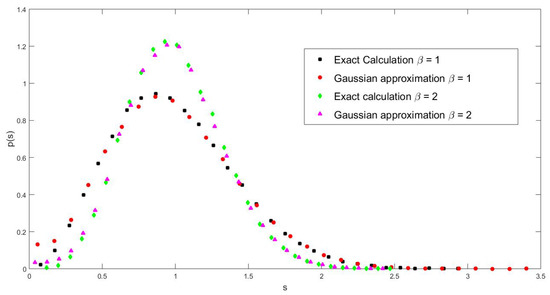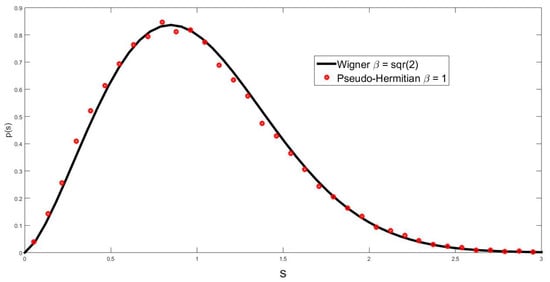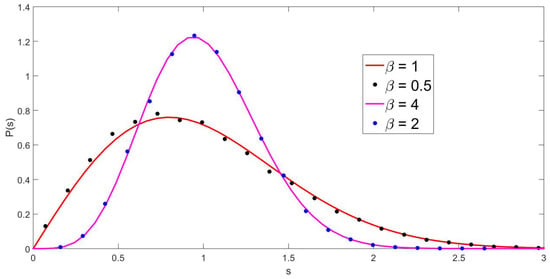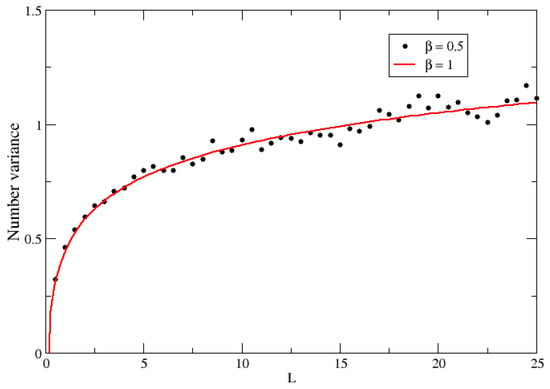Abstract
The Dyson index, , plays an essential role in random matrix theory, as it labels the so-called “three-fold way” that refers to the symmetries satisfied by ensembles under unitary transformations. As is known, its 2, and 4 values denote the orthogonal, unitary, and symplectic classes, whose matrix elements are real, complex, and quaternion numbers, respectively. It functions, therefore, as a measure of the number of independent non-diagonal variables. On the other hand, in the case of ensembles, which represent the tridiagonal form of the theory, it can assume any real positive value, thus losing that function. Our purpose, however, is to show that, when the Hermitian condition of the real matrices generated with a given value of is removed, and, as a consequence, the number of non-diagonal independent variables doubles, non-Hermitian matrices exist that asymptotically behave as if they had been generated with a value Therefore, it is as if the index were, in this way, again operative. It is shown that this effect happens for the three tridiagonal ensembles, namely, the –Hermite, the –Laguerre, and the –Jacobi ensembles.
1. Introduction
The possibility of reducing a full matrix into a tridiagonal matrix by employing unitary transformations inspired some researchers [1] to search for ensembles of tridiagonal matrices that would have the same properties of the ensembles of random matrix theory (RMT) [2]. This objective has been achieved in a seminal paper [3] in which ensembles of tridiagonal Hermitian matrices are constructed for the classes associated with the Hermite and the Laguerre polynomials. The tridiagonal matrices associated with the Jacobi polynomials, on the other hand, were obtained in [4,5,6]. In these three tridiagonal ensembles, the Dyson index, , which in RMT has the integer values and can assume any positive real value. Therefore, the ensemble generalized Dyson’s “three-fold way” [7] associated with invariance under the orthogonal (GOE), unitary (GUE), and symplectic (GSE) transformations of the three classes of the Gaussian ensemble.
Once the ensembles were established, it was natural to investigate what happens if its Hermitian condition is removed. Of course, this interest parallels the introduction of the non-Hermitian random matrices by Ginibre [8] a few years after Wigner’s proposal of the Hermitian random matrices by the end of the 1950s [9]. In the tridiagonal Hermite case, this investigation was undertaken in ref. [10], in which, besides the question of introducing non-Hermiticity in ensembles, there was also another motivation.
In fact, the main interest of this study was in the special class of non-Hermitian operators in which the operator is connected to its adjoint by a similarity transformation; namely, it satisfies the condition
where A is non-Hermitian and is Hermitian. This condition defines a pseudo-Hermitian operator [11], and it implies that its spectrum is made of real or complex conjugate eigenvalues. This kind of non-Hermitian operator attracted a lot of interest with the discovery that Hamiltonian invariants under the combined parity and time-reversal transformation, called PT symmetry, also have real or complex conjugate spectra [12,13,14]. This led to an extension of quantum mechanics to include this special class of non-Hermitian Hamiltonians with PT symmetry [14] (see [15] for a review).
Concomitantly, there have been attempts to find, in the context of random matrix theory (RMT), ensembles of matrices satisfying the above relationship [16,17]. In [10], it was shown that in its tridiagonal form, the removal of the Hermitian condition produces matrices that satisfy the above pseudo-Hermitian constraint. We are here revisiting that work to report an important result that has since been overlooked. In fact, there, it was shown that the eigenvalues of the non-Hermitian ensemble are real and distributed with the same semi-circle law as those of the Hermitian ensemble. However, not much could be said about the fluctuations. In this respect, what we have now found is that asymptotically, that is, for arbitrary large matrices, the passage to non-Hermiticity is accompanied by the doubling of Dyson’s index. It is important to emphasize that, in order for this doubling index effect to occur, it is necessary to take into account the presence of traces in the structure of the joint distributions of matrix elements in the case of the Hermite and Laguerre ensembles. In the Jacobi ensemble, it will be shown that the important quantity is the variance of the diagonal and the off-diagonal elements. Therefore, the effect occurs in the three ensembles. Moreover, it affects the short-range statistics, measured by the nearest-neighbor spacing distribution (NNSD), and the long-range statistics, measured by the number variance. This is illustrated with plots of NNSD for the three ensembles and number variance for the Jacobi ensemble. The figures with similar results for the two other ensembles are omitted.
2. Preliminares
We start by recalling some results from [10]. Considering the general case of a non-Hermitian tridiagonal matrix, A, with a diagonal an upper sub-diagonal , and a lower sub-diagonal in which elements can assume any real value, it is easily proved that the matrix A is pseudo-Hermitian. In fact, by defining the diagonal matrix , whose elements are given by
it is immediately verified that A and its adjoint satisfy Equation (1), belonging, therefore, to the class of pseudo-Hermitian matrices. Moreover, by defining the diagonal matrix whose elements are obtained by taking the square roots of the elements of , that is,
we find that, if the products are positive, then we can define a matrix
which is Hermitian and iso-spectral with A and whose diagonal is the same of A, while the sub-diagonals are the geometrical means .
Considering now the distribution
with a first moment and a second moment it is found that by constructing a new variable where x and y are both sorted, its distribution is the K-distribution
where is a modified Bessel function of the second kind. For large values of , the contributions to the K-distribution come from large values of its argument. This being the case, we are allowed to replace in the expression of the Bessel function with its asymptotic expression , which leads to
Using now the gamma function duplication formula
and the fact that, for large ,
it is found that the distribution of the geometrical mean variable can be approximated as
where
Let us now consider the beta distribution
in the asymptotic situation in which and In this case, we can make the expansion
neglecting higher-order terms. Imposing then that after approximating the gamma functions by their Stirling expressions, it is found that the beta distribution approaches the normal distribution
For normal distributions, by constructing the mean quantity
in which is Gaussian distributed with an average of and variances of it is then found that y is distributed according to the normal distribution
3. The Pseudo-Hermitian Hermite– Ensemble
A matrix of the Hermite– ensemble is a Hermitian tridiagonal matrix whose joint density distribution of the matrix elements is given by
such that the diagonal elements are normally distributed, namely while the off-diagonal elements are distrtributed according to as seen in Equation (11), where and is a real positive parameter. Using the lemmas of the tridiagonal form that relate the Vandermonde determinant to the off-diagonal elements, it is then found that the joint density distribution of the eigenvalues is given by [3]
By expanding the determinant of the characteristic polynomial, it is obtained that its average satisfies the recursion relationship
such that a comparison with Hermite polynomials recursion relationships leads to the identity This means that, asymptotically, the eigenvalues occupy the same compact support of the zeros of Hermite polynomials [18] defined by Wigner’s semi-circle law [2],
Considering the fluctuations, we assume that the nearest-neighbor distribution (NND) can be described by the NND of the matrices that is found to be given by the generalized Wigner surmise
where
Let us now remove the Hermitian condition of by filling one of the off-diagonals by new random variables In [10], this was carried out by sorting the elements of the two sub-diagonals from the same distribution of the Hermitian case. However, this choice does not keep the structure of the above joint distribution of elements in terms of the exponential of the trace. If we sort them instead from using Equation (5), the joint distribution of the non-Hermitian matrices can be written as
In this case, the recursion relationship of the average characteristic polynomial becomes
which leads to the semi-circle law in which is replaced by
From the preliminary results stated above, is a pseudo-Hermitian matrix whose eigenvalues are real, and, at the same time, they also are eigenvalues of a Hermitian matrix The diagonal elements of are the same of , while the off-diagonal elements are the geometrical mean of the elements and are therefore distributed according to Equation (6). Using, then, the asymptotic of these functions and Equation (7), the joint density distribution of the approaches the distribution
which is just the joint distribution of the Hermitian case with a replaced by The joint distribution of the eigenvalues is then given by Equation (18), with replaced by In Figure 1, this effect is illustrated in the case of the eigenvalues of the pseudo-Hermitian –Hermite ensemble.

Figure 1.
NNSD for pseudo-Hermitian matrices of size n = 128 of the Hermite (blue circles) and Laguerre ensembles (red squares) for the indicated values of and The black full lines were calculated with Wigner surmise and Equation (21), with and respectively.
4. The Pseudo-Hermitian Laguerre– Ensemble
Let B be the bidiagonal matrix with diagonal elements and sub-diagonal elements , whose joint distribution of the elements is given by
where with Therefore, the elements obey the distribution where for the diagonal elements and for the sub-diagonal elements. The Laguerre ensemble is then defined as the tridiagonal matrix
As shown in Ref. [3], in order to change from a bidiagonal to a tridiagonal matrix, the Jacobian
is used to give
such that, using lemmas of the tridiagonal form, it is found that the joint distribution of the eigenvalues is given by [3]
Let us start by obtaining the average characteristic polynomial whose derivation is also valid in the pseudo-Hermitian case. By expanding the determinant polynomial and taking the average of elements, we have the recursion relationship
where the R-polynomials satisfy the recursion relationship
These above relationships, respectively, are solved by the two generalized Laguerre polynomials and The density of the eigenvalues, which is also that of the zeros of the polynomials, is given by the Marchenko–Pastur expression
where , and from this, we have the cumulative function
To construct the pseudo-Hermitian–Laguerre ensemble, we introduce a new bidiagonal matrix C with a diagonal and a lower sub-diagonal whose elements are sorted from the same distribution of the elements of B. Once this is carried out, a non-Hermitian –Laguerre matrix is obtained by taking the product that produces the matrix
Immediately, the pseudo-Hermitian nature of this matrix is proved, and, furthermore, it can be seen that it is iso-spectral with the Hermitian matrix in which D is the bidiagonal matrix
Denoting the diagonal elements as and the sub-diagonals as of course, they are distributed according to , as per Equation (6), with for the diagonals and for the sub-diagonals. Replacing with its asymptotic expression, we obtain
and for the eigenvalues, we obtain
In Figure 1, the effect is illustrated in the case of the pseudo-Hermitian –Laguerre ensemble.
5. The Pseudo-Hermitian Jacobi– Ensemble
A matrix of the Jacobi ensemble is a Hermitian tridiagonal matrix [4,5,6,19]
where the diagonal elements are given by
and the off-diagonal elements are given by
where, with the are -distributed, following Equation (12), with variables given by
and
aside from the special cases It has been proven that the joint distribution of the eigenvalues of the these matrices is given by
The density of the eigenvalues satisfies an inverted semi-circle law
where the constant c is a small parameter necessary to adjust the results of the numerical simulations. As a consequence, the unfolding of the eigenvalues is performed with the cumulative function
As the above parameters of the beta distributions increase for large matrix sizes, it is justified to assume that when , they can be replaced by the Gaussian approximations
and
which were derived in the preliminary section.
The important point to observe in these equations is that the average positions and the variances of the above Gaussians approach zero when the size n of the matrices becomes arbitrarily large. As a consequence, the above expressions connecting the matrix elements to the variables can be linearized as for the diagonal elements and for the off-diagonal ones. These approximated expressions show that, asymptotically, the diagonal and the off-diagonal elements decouple, and, moreover, all elements become Gaussian distributed, such that we have for the diagonal elements
and for the off-diagonal elements, we have
Therefore, the off-diagonal elements fluctuate around one, while the diagonal ones fluctuate around zero. Thus, it is reasonable to expect that the off-diagonal elements have a determinant role in the behavior of the eigenvalue properties inasmuch as, for tridiagonal matrices, the eigenvalues are directly connected to the off-diagonal elements. The precision of this approximated description as compared to the exact expressions is attested to in Figure 2.

Figure 2.
Comparison of the Gaussian approximation with the exact calculation of NNSD for and , as indicated in the figure.The calculations were performed with 50 matrices of size n = 450.
Therefore, the matrix elements are constructed using the 2n−1 random components of the vector , which are shared by both the diagonal and the sub-diagonal elements. Thus, it does not seem to have a clear way to remove the Hermitian condition. On the other hand, the basic idea of the 2 Dyson effect is that it is caused by doubling the number of independent variables, especially those in the off-diagonal matrix elements. Considering now the removal of the Hermitian condition of the matrices, this can be executed by just sorting a new vector from which only the odd elements are used to fill the lower sub-diagonal. Therefore, only the number of odd elements are doubled. This defines a lower sub-diagonal whose elements differ from by odd terms. As the elements of these two off-diagonal are positive, these non-Hermitian matrices, besides being pseudo-Hermitian, are iso-spectral with the Hermitian matrix whose off-diagonal elements are given by
Turning now to the asymptotic description, consistent with our level of approximations, the geometrical mean of the two off-diagonal elements can be linearized as
where the primes denote variables belonging to the sub-diagonal. Using the result (16) from Section 2, we can write
such that the factor affects the variances of the odd k terms as
The above expression shows the occurrence of a effect, which affects only the odd terms of the off-diagonal elements. This means that we are dealing with a hybrid pseudo-Hermitian ensemble that combines the even elements generated with and the odd ones sorted with The evidence from numerical simulations (see Figure 3) suggests that the spectral statistics, that is, the NNSD, can be fitted with a parameter It is interesting to observe that is the geometric mean of and To ’fix’ this, what we can do is, in the pseudo-Hermitian case, generate the even elements with a parameter while sorting the odd elements with The results of the numerical simulations following this procedure demonstrate a clear effect, as is shown in Figure 4 for the NNSD and in Figure 5 for the number variance.

Figure 3.
The hybrid pseudo-Hermitian –Jacobi ensemble in which even elements are sorted with , while the odd ones, asymptotically, become sorted with The blue line is calculated with Equation (21) using as parameters the geometric mean of and , that is, . The calculations were performed with 50 matrices of size n = 360.

Figure 4.
NNSD for 100 matrices of size 120 in which the even elements of the pseudo-Hermitian –Jacobi ensemble are sorted with (black and blue dots) for the indicated values of beta. The full lines were calculated with Wigner surmise, as seen in Equation (21), with and respectively.

Figure 5.
The verification of the 2 effect in the number variance statistics: black dots were calculated with 600 matrices of size n = 120 of the pseudo-Hermitian –Jacobi ensemble sorted with , and the red full line corresponds to the GOE number variance.
6. Conclusions
In conclusion, we have extended the universality of RMT Wigner–Dyson statistics to a class of non-Hermitian matrices with real eigenvalues. Matrices of this class are connected to their adjoints by a similarity transformation, a discrete symmetry condition that defines a pseudo-Hermitian matrix. In our case, the matrices are constructed by removing the Hermitian condition of the tridiagonal matrices of the three so-called ensembles. By doing this, the number of off-diagonal independent elements doubles, and, as also occurs in standard random matrix theory, the Dyson index also doubles. One obvious question is to investigate if this effect can be observed in pseudo-Hermitian full random matrices. However, it is not clear how, in this case, a pseudo-Hermitian model can be constructed in which the number of independent variables doubles. Another question is if the effect can be observed in a Hamiltonian with real eigenvalues, as this can lead to a link between PT symmetry and quantum chaos. As a final remark, we emphasize that the origin of the 2 effect stems from the asymptotic behavior of the geometric mean calculated with the distribution functions of the matrix elements of the three ensembles. This suggests another universality associated with random matrix theories.
Author Contributions
Conceptualization, M.P.P.; Formal analysis, C.A.G.; Investigation, C.A.G.; Writing—review & editing, M.P.P. All authors have read and agreed to the published version of the manuscript.
Funding
M.P.P. is a member of the Brazilian National Institute of Science and Technology Quantum Information (INCT-IQ). C.A.G. is supported by the Brazilian agency CAPES under grant number 88887.616887/2021-00.
Institutional Review Board Statement
Not applicable.
Conflicts of Interest
The authors declare no conflict of interest.
References
- Baker, T.; Forrester, P. The Calogero-Sutherland Model and Generalized Classical Polynomials. Commun. Math. Phys. 1997, 188, 175. [Google Scholar] [CrossRef]
- Mehta, M.L. Random Matrices, 3rd ed.; Academic Press: London, UK, 2004. [Google Scholar]
- Dumitriu, I.; Edelman, A. Matrix models for beta ensembles. J. Math. Phys. 2002, 43, 5830. [Google Scholar] [CrossRef]
- Lippert, R.A. A matrix model for the β-Jacobi ensemble. J. Math. Phys. 2003, 44, 4807–4816. [Google Scholar] [CrossRef]
- Killip, T.; Nenciu, I. Matrix models for circular ensembles. Int. Math. Res. Not. 2004, 50, 2665. [Google Scholar] [CrossRef]
- Edelman, A.; Sutton, B. The Beta-Jacobi Matrix Model, the CS Decomposition, and Generalized Singular Value Problems. Found. Comput. Math. 2008, 8, 259–285. [Google Scholar] [CrossRef]
- Dyson, F.J. The Threefold Way. Algebraic Structure of Symmetry Groups and Ensembles in Quantum Mechanics. J. Math. Phys. 1962, 3, 1199. [Google Scholar] [CrossRef]
- Ginibre, J. Statistical Ensembles of Complex, Quaternion, and Real Matrices. J. Math. Phys. 1965, 6, 440. [Google Scholar] [CrossRef]
- Wigner, E.P. On the Distribution of the Roots of Certain Symmetric Matrices. Ann. Math. 1958, 68, 325. [Google Scholar] [CrossRef]
- Bohigas, O.; Pato, M.P. Non-Hermitian β-ensemble with real eigenvalues. AIP Adv. 2013, 3, 032130. [Google Scholar] [CrossRef]
- Mostafazadeh, A. Pseudo-Hermiticity versus PT symmetry: The necessary condition for the reality of the spectrum of a non-Hermitian Hamiltonian. J. Math. Phys. 2002, 43, 205–214. [Google Scholar] [CrossRef]
- Bender, C.M.; Boettcher, S. Real Spectra in Non-Hermitian Hamiltonians Having PT-Symmetry. Phys. Rev. Lett. 1998, 80, 5243. [Google Scholar] [CrossRef]
- Bender, C.M.; Boettcher, S.; Meisinger, P.N. PT-symmetric quantum mechanics. J. Math. Phys. 1999, 40, 2201. [Google Scholar] [CrossRef]
- Bender, C.M.; Brody, D.C.; Jones, H.F. Complex Extension of Quantum Mechanics. Phys. Rev. Lett. 2002, 89, 270401. [Google Scholar] [CrossRef] [PubMed]
- Bender, C.M. Making sense of non-Hermitian Hamiltonians. Rep. Prog. Phys. 2007, 70, 947. [Google Scholar] [CrossRef]
- Jain, S.R. Random matrix theories and exactly solvable models. Czechoslov. J. Phys. 2006, 56, 1021–1032. [Google Scholar] [CrossRef]
- Srivastava, S.C.L.; Jain, S.R. Pseudo-Hermitian random matrix theory. Fortschr. Phys. 2013, 61, 276. [Google Scholar] [CrossRef]
- Szego, G. Orthogonal Polynomials; American Mathematical Society: New York, NY, USA, 1939. [Google Scholar]
- Forrester, P.J. Log-Gases and Random Matrices; Princeton University Press: Princeton, NJ, USA, 2010. [Google Scholar]
Disclaimer/Publisher’s Note: The statements, opinions and data contained in all publications are solely those of the individual author(s) and contributor(s) and not of MDPI and/or the editor(s). MDPI and/or the editor(s) disclaim responsibility for any injury to people or property resulting from any ideas, methods, instructions or products referred to in the content. |
© 2023 by the authors. Licensee MDPI, Basel, Switzerland. This article is an open access article distributed under the terms and conditions of the Creative Commons Attribution (CC BY) license (https://creativecommons.org/licenses/by/4.0/).